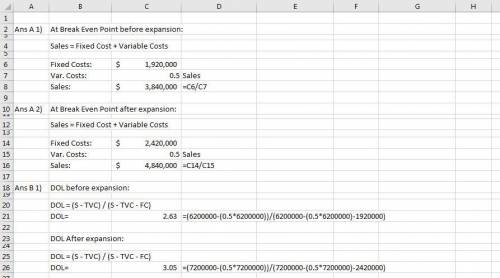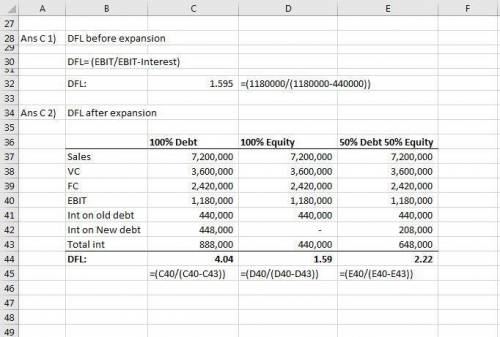
Business, 02.06.2020 11:58 irenemonte
Delsing Canning Company is considering an expansion of its facilities. Its current income statement is as follows:
Sales $ 6,200,000
Variable costs (50% of sales) 3,100,000
Fixed costs 1,920,000
Earnings before interest and taxes (EBIT) $ 1,180,000
Interest (10% cost) 440,000
Earnings before taxes (EBT) $ 740,000
Tax (30%) 222,000
Earnings after taxes (EAT) $ 518,000
Shares of common stock 320,000
Earnings per share $ 1.62
The company is currently financed with 50 percent debt and 50 percent equity (common stock, par value of $10). In order to expand the facilities, Mr. Delsing estimates a need for $3.2 million in additional financing. His investment banker has laid out three plans for him to consider:
Sell $3.2 million of debt at 14 percent.
Sell $3.2 million of common stock at $20 per share.
Sell $1.60 million of debt at 13 percent and $1.60 million of common stock at $25 per share.
Variable costs are expected to stay at 50 percent of sales, while fixed expenses will increase to $2,420,000 per year. Delsing is not sure how much this expansion will add to sales, but he estimates that sales will rise by $1.60 million per year for the next five years.
Delsing is interested in a thorough analysis of his expansion plans and methods of financing. He would like you to analyze the following:
Required:
a. The break-even point for operating expenses before and after expansion (in sales dollars). (Enter your answers in dollars not in millions, i. e, $1,234,567.)
b. The degree of operating leverage before and after expansion. Assume sales of $6.2 million before expansion and $7.2 million after expansion. Use the formula: DOL = (S − TVC) / (S − TVC − FC). (Round your answers to 2 decimal places.)
c-1. The degree of financial leverage before expansion. (Round your answers to 2 decimal places.)
c-2. The degree of financial leverage for all three methods after expansion. Assume sales of $7.2 million for this question. (Round your answers to 2 decimal places.)
d. Compute EPS under all three methods of financing the expansion at $7.2 million in sales (first year) and $10.1 million in sales (last year). (Round your answers to 2 decimal places.)

Answers: 2


Other questions on the subject: Business

Business, 21.06.2019 18:20, ayeelol1447
The sticky-price theory asserts that the output prices of some goods and services adjust slowly to changes in the price level. suppose firms announce the prices for their products in advance, based on an expected price level of 100 for the coming year. many of the firms sell their goods through catalogs and face high costs of reprinting if they change prices. the actual price level turns out to be 110. faced with high menu costs, the firms that rely on catalog sales choose not to adjust their prices. sales from catalogs will
Answers: 3

Business, 22.06.2019 04:00, hahalol123goaway
Which law would encourage more people to become homeowners but not encourage risky loans that could end in foreclosure? options: offering first time homebuyers tax-free accounts to save for down payments requiring all mortgages to be more affordable, interest-only loans outlawing home inspections and appraisals by mortgage companies limiting rent increases to less than 2% a year
Answers: 2

Business, 22.06.2019 10:40, charlesrogers38
What would happen to the equilibrium price and quantity of lattés if the cost to produce steamed milk
Answers: 1

Business, 22.06.2019 12:30, badgirl2005
Suppose you win a small lottery and have the choice of two ways to be paid: you can accept the money in a lump sum or in a series of payments over time. if you pick the lump sum, you get $2,950 today. if you pick payments over time, you get three payments: $1,000 today, $1,000 1 year from today, and $1,000 2 years from today. 1) at an interest rate of 6% per year, the winner would be better off accepting the (lump sum / payments over time), since it has the greater present value. 2) at an interest rate of 9% per year, the winner would be better off accepting the (lump sum / payments over time), since it has the greater present value. 3) years after you win the lottery, a friend in another country calls to ask your advice. by wild coincidence, she has just won another lottery with the same payout schemes. she must make a quick decision about whether to collect her money under the lump sum or the payments over time. what is the best advice to give your friend? a) the lump sum is always better. b) the payments over time are always better. c) it will depend on the interest rate; advise her to get a calculator. d) none of these answers is good advice.
Answers: 2
You know the right answer?
Delsing Canning Company is considering an expansion of its facilities. Its current income statement...
Questions in other subjects:


English, 21.10.2019 13:30

Advanced Placement (AP), 21.10.2019 13:30

Mathematics, 21.10.2019 13:30





English, 21.10.2019 13:30

Mathematics, 21.10.2019 13:30





